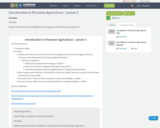
Overview:Students will discover why “variability” is the driving factor behind precision agriculture.
- Subject:
- Agriculture
- Material Type:
- Lecture Notes
- Lesson
- Author:
- Carmel Miller
- Date Added:
- 08/05/2021

Overview:Students will discover why “variability” is the driving factor behind precision agriculture.

The microscopic world is full of phenomena very different from what we see in everyday life. Some of those phenomena can only be explained using quantum mechanics. This activity introduces basic quantum mechanics concepts about electrons that are essential to understanding modern and future technology, especially nanotechnology. Start by exploring probability distribution, then discover the behavior of electrons with a series of simulations.
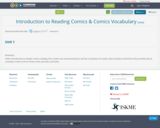
Video introduction to simple comics reading, how comics are representational, and the vocabulary of comics. Also includes a brief list of the possible jobs in creating a comic such as writer, artist, penciler, and inker.
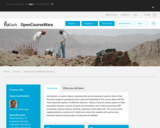
Introduction to seismic theory, measurements and processing of seismic data to final focussed image for geological and/or physical interpretation.This course deals with the most important aspects of reflection seismics. Theory of seismic waves, aspects of data acquisition (seismic sources, receivers and recorders), and of data processing (CMP processing, velocity analysis, stacking, migration) will be dealt with. The course will be supplemented by a practical of 6 afternoons where the students will see the most important data-processing steps via exercises (in Matlab).
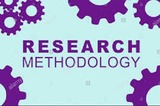
"An Introduction to Research Methodology" contain fundamantal concepts like meaning of research, characteristics of Research, Types of Research, difference between method & methodology, process of Research and sampling methods.

Students will learn about school law, the ethical and legal influences that impact students and teaching. Law, Ethics, and Teacher Professionalism; The U.S. Legal System; Teachers' Rights and Responsibilities; Religious Freedom and Schools; Diversity; Students and the Law This presentation follows along with information found in the textbook: Kauchak, D. P., & Eggen, P. D. (2017). Introduction to teaching: Becoming a professional. Pearson.

Understand the difference between race and ethnicityDefine a majority group (dominant group)Define a minority group (subordinate group)

Understand the U.S. class structureDescribe several types of social mobilityRecognize characteristics that define and identify class
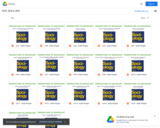
Sociology 204/205 power points. Chapter 1-17 with audio offered.
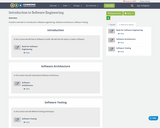
Contains overview on introduction Software engineering, Software Architecture, Software Testing

This resource provides a basic introduction to what logic is, including a definition of an argument and how to distinguish between arguments and other forms of speech, such as explanations, as well as the distinction between inductive and deductive arguments.

Knowing instructors have experiential knowledge of discipline-specific information and instruction success rates, this course is intended to convey an alternative to face-to-face instruction and aims to increase the commitment and desire of faculty to utilize online tools for instruction. Users I make no assumption about age or gender of learners; however, educational discipline and background are acknowledged, as well as the assumption that faculty have the knowledge to effectively operate a smart deviceSelf-Paced Study this course can be utilized as self-paced and focused on only those tools best suited according to discipline. Learning Objectives Learners will choose commonly utilized tools, technology and/or digital sources and identify technology(s) support of blended or fully online environment.Learners will use a technology evaluation rubric to evaluate a technology tool selected to meet a specific learning goal.Learners will develop a Technology Integration Professional Development Plan that will include their areas of need and a desire of use.
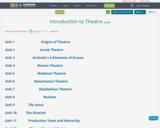
Lecture notes, internet links and vocabulary lists for a core curriculum Introduction to Theatre college level course.

The attached lesson plan is designed for Grade 11 English Language Arts students. Students will analyze and evaluate the elements of literary text, build background knowledge to clarify text and deepen understanding, and use relevant evidence to assist in analysis and reflection of complex text. This lesson plan addresses the following NDE Standard: NE LA 12.1.6g, NE LA 12.1.6I, and NE LA 12.1.6L It is expected that this lesson plan will take students 50 minutes to complete.
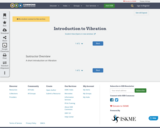
A short introduction on Vibration
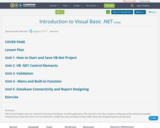
This tutorial explain step -by- step how to develop visual basic .net 2012 application. The Lecturer notes has complete coding part of the tutorial is available. Using lecturer notes the viewer can try themselves modify the code and improve their skills. Each unit designed based on lesson plan

This social media literacy unit introduces students to foundational skills in analyzing images and social media posts. It also reenforces critical thinking questions that can be applied to various forms of media. This unit was taught to 9th grade students but is easily adaptible to a range of secondary classrooms. It was also taught in conjunction with another unit focused on social media platforms and content.

Political thought, otherwise known as political theory or philosophy, is the study of questions concerning power, justice, rights, law, and other issues pertaining to governance. This course examines major texts in the history of political thought and asks how different views on human nature inform the design of government. Upon successful completion of this course, the student will be able to: summarize the passage of political thought through the classical, Renaissance, and Enlightenment periods and based on the works of Plato, Aristotle, Machiavelli, Hobbes, Locke, Rousseau, Tocqueville, and Marx; compare and contrast the differences between Plato and Aristotle with regard to their understandings of the nature of the person, ethics, society, citizenship, and governance; explain the historical and intellectual context in which the political thought that helped to develop the modern state came to be; compare and contrast the concepts of justice, freedom, equality, citizenship, and sovereignty in the works of Machiavelli, Hobbes, Locke, and Rousseau; explain the different versions of, and importance of, 'the state of nature' to political thought; identify the influences of Hobbes, Locke, and Rousseau on the development of the United States Constitution; summarize the thoughts of Alexis de Tocqueville on the American political landscape, particularly with regard to religion and equality, and why this has importance beyond the American context; explain Karl Marx's world view, with particular regard to his critique of democracy and the modern, politically liberal, state; how it came to be; and its fundamental link to capitalism. (Political Science 201)
The goal of the course is to give computer literacy and skills to teachers of the PEP-TEC school located in the sub-urban province of Monrovia, the capital of Liberia. The first course is introduction to Windows which is a pre-requisite to MS Word, Excel that will also form the core modules of this curriculum. The curriculum leads teachers/learners to creading e-portals for remote learning.

The aim of this session is to cover the basic theory of compact linear operators on Banach spaces. This includes definitions and statements of the background and main results, with illustrative examples and some proofs.
Target audience: This material is accessible to anyone who has a basic knowledge of metric space topology, and who knows what a bounded linear operator on a Banach space is. It is most likely to be suitable for postgraduate students or final year undergraduates.